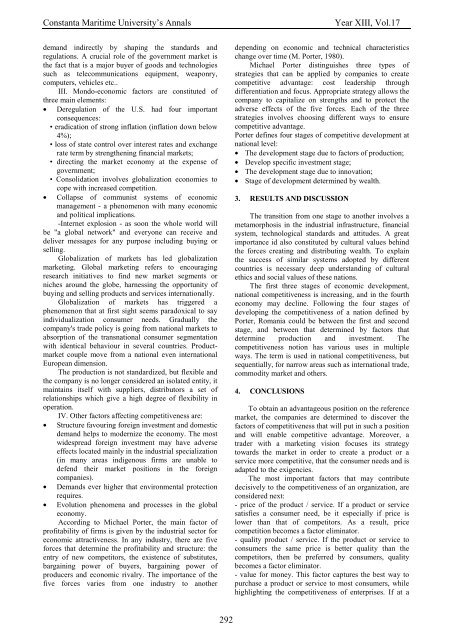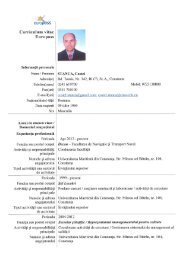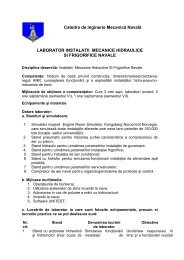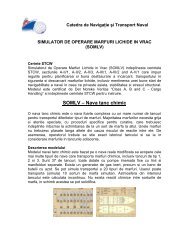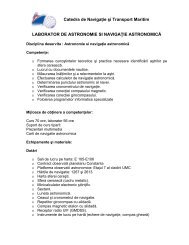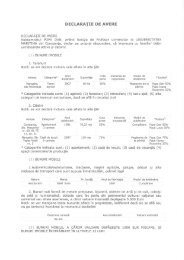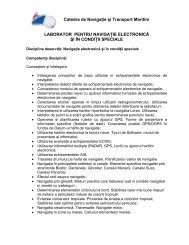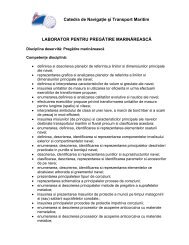Constanta Maritime University's Annals Year XIII, Vol.17 291 ...
Constanta Maritime University's Annals Year XIII, Vol.17 291 ...
Constanta Maritime University's Annals Year XIII, Vol.17 291 ...
You also want an ePaper? Increase the reach of your titles
YUMPU automatically turns print PDFs into web optimized ePapers that Google loves.
<strong>Constanta</strong> <strong>Maritime</strong> University’s <strong>Annals</strong> <strong>Year</strong> <strong>XIII</strong>, <strong>Vol.17</strong><br />
demand indirectly by shaping the standards and<br />
regulations. A crucial role of the government market is<br />
the fact that is a major buyer of goods and technologies<br />
such as telecommunications equipment, weaponry,<br />
computers, vehicles etc..<br />
III. Mondo-economic factors are constituted of<br />
three main elements:<br />
• Deregulation of the U.S. had four important<br />
consequences:<br />
• eradication of strong inflation (inflation down below<br />
4%);<br />
• loss of state control over interest rates and exchange<br />
rate term by strengthening financial markets;<br />
• directing the market economy at the expense of<br />
government;<br />
• Consolidation involves globalization economies to<br />
cope with increased competition.<br />
• Collapse of communist systems of economic<br />
management - a phenomenon with many economic<br />
and political implications.<br />
-Internet explosion - as soon the whole world will<br />
be "a global network" and everyone can receive and<br />
deliver messages for any purpose including buying or<br />
selling.<br />
Globalization of markets has led globalization<br />
marketing. Global marketing refers to encouraging<br />
research initiatives to find new market segments or<br />
niches around the globe, harnessing the opportunity of<br />
buying and selling products and services internationally.<br />
Globalization of markets has triggered a<br />
phenomenon that at first sight seems paradoxical to say<br />
individualization consumer needs. Gradually the<br />
company's trade policy is going from national markets to<br />
absorption of the transnational consumer segmentation<br />
with identical behaviour in several countries. Productmarket<br />
couple move from a national even international<br />
European dimension.<br />
The production is not standardized, but flexible and<br />
the company is no longer considered an isolated entity, it<br />
maintains itself with suppliers, distributors a set of<br />
relationships which give a high degree of flexibility in<br />
operation.<br />
IV. Other factors affecting competitiveness are:<br />
• Structure favouring foreign investment and domestic<br />
demand helps to modernize the economy. The most<br />
widespread foreign investment may have adverse<br />
effects located mainly in the industrial specialization<br />
(in many areas indigenous firms are unable to<br />
defend their market positions in the foreign<br />
companies).<br />
• Demands ever higher that environmental protection<br />
requires.<br />
• Evolution phenomena and processes in the global<br />
economy.<br />
According to Michael Porter, the main factor of<br />
profitability of firms is given by the industrial sector for<br />
economic attractiveness. In any industry, there are five<br />
forces that determine the profitability and structure: the<br />
entry of new competitors, the existence of substitutes,<br />
bargaining power of buyers, bargaining power of<br />
producers and economic rivalry. The importance of the<br />
five forces varies from one industry to another<br />
292<br />
depending on economic and technical characteristics<br />
change over time (M. Porter, 1980).<br />
Michael Porter distinguishes three types of<br />
strategies that can be applied by companies to create<br />
competitive advantage: cost leadership through<br />
differentiation and focus. Appropriate strategy allows the<br />
company to capitalize on strengths and to protect the<br />
adverse effects of the five forces. Each of the three<br />
strategies involves choosing different ways to ensure<br />
competitive advantage.<br />
Porter defines four stages of competitive development at<br />
national level:<br />
• The development stage due to factors of production;<br />
• Develop specific investment stage;<br />
• The development stage due to innovation;<br />
• Stage of development determined by wealth.<br />
3. RESULTS AND DISCUSSION<br />
The transition from one stage to another involves a<br />
metamorphosis in the industrial infrastructure, financial<br />
system, technological standards and attitudes. A great<br />
importance id also constituted by cultural values behind<br />
the forces creating and distributing wealth. To explain<br />
the success of similar systems adopted by different<br />
countries is necessary deep understanding of cultural<br />
ethics and social values of these nations.<br />
The first three stages of economic development,<br />
national competitiveness is increasing, and in the fourth<br />
economy may decline. Following the four stages of<br />
developing the competitiveness of a nation defined by<br />
Porter, Romania could be between the first and second<br />
stage, and between that determined by factors that<br />
determine production and investment. The<br />
competitiveness notion has various uses in multiple<br />
ways. The term is used in national competitiveness, but<br />
sequentially, for narrow areas such as international trade,<br />
commodity market and others.<br />
4. CONCLUSIONS<br />
To obtain an advantageous position on the reference<br />
market, the companies are determined to discover the<br />
factors of competitiveness that will put in such a position<br />
and will enable competitive advantage. Moreover, a<br />
trader with a marketing vision focuses its strategy<br />
towards the market in order to create a product or a<br />
service more competitive, that the consumer needs and is<br />
adapted to the exigencies.<br />
The most important factors that may contribute<br />
decisively to the competitiveness of an organization, are<br />
considered next:<br />
- price of the product / service. If a product or service<br />
satisfies a consumer need, be it especially if price is<br />
lower than that of competitors. As a result, price<br />
competition becomes a factor eliminator.<br />
- quality product / service. If the product or service to<br />
consumers the same price is better quality than the<br />
competitors, then be preferred by consumers, quality<br />
becomes a factor eliminator.<br />
- value for money. This factor captures the best way to<br />
purchase a product or service to most consumers, while<br />
highlighting the competitiveness of enterprises. If at a


